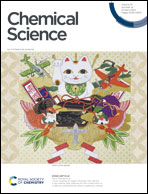Disrupting the Hofmeister bias in salt liquid–liquid extraction with an arylethynyl bisurea anion receptor†
Abstract
Host-mediated liquid–liquid extraction is a convenient method for the separation of inorganic salts. However, selective extraction of an anion, regardless of its hydrophilicity or lipophilicity as qualitatively described by its place in the Hofmeister series, remains challenging. Herein we report the complete disruption of the Hofmeister-based ordering of anions in host-mediated extraction by a rigidified tweezer-type receptor possessing remarkably strong anion-binding affinity under the conditions examined. Experiments introduce a convenient new method for determination of anion binding using phosphorus inductively coupled plasma mass spectrometry (ICP-MS) to measure extraction of tetra-n-butylphosphonium (TBP+) salts from water into nitrobenzene, specifically examining the disrupting effect of the added arylethynyl bisurea anion receptor. In the absence of the receptor, the salt partitioning follows the expected Hofmeister-type ordering favoring the larger, less hydrated anions; the analysis yields the value −24 kJ mol−1 for the standard Gibbs energy of partitioning of TBP+ cation from water into nitrobenzene at 25 °C. Selectivity is markedly changed by the addition of receptor to the nitrobenzene and is concentration dependent, giving rise to three selectivity regimes. We then used SXLSQI liquid–liquid equilibrium analysis software developed at Oak Ridge National Laboratory to fit host-mediated extraction equilibria for TBP+ salts of Cl−, Br−, I−, and NO3− to the distribution data. While the reverse-Hofmeister 1 : 1 binding of the anions by the receptor effectively cancels the Hofmeister selectivity of the TBPX partitioning into nitrobenzene, formation of unexpected 2 : 1 receptor : anion complexes favoring Cl− and Br− dominates the selectivity at elevated receptor concentrations, producing the unusual order Br− > Cl− > NO3− > I− in anion distribution wherein a middle member of the series is selected and the most lipophilic anion is disfavored. Density functional theory calculations confirmed the likelihood of forming 2 : 1 complexes, where Cl− and Br− are encapsulated by two receptors adopting energetically competitive single or double helix structures. The calculations explain the rare non-Hofmeister preference for Br−. This example shows that anion receptors can be used to control the selectivity and efficiency of salt extraction regardless of the position of the anion in the Hofmeister series.



 Please wait while we load your content...
Please wait while we load your content...